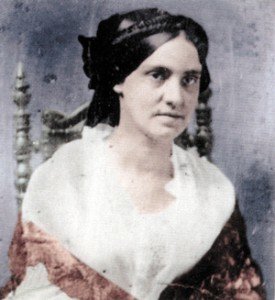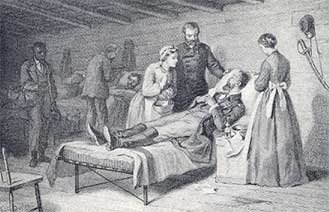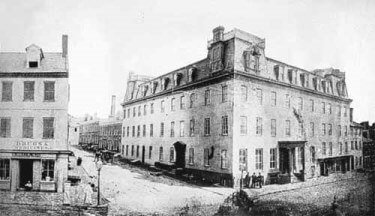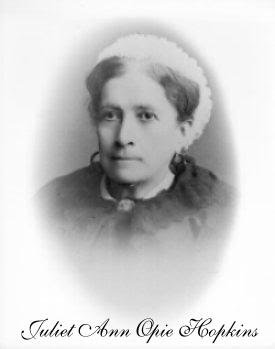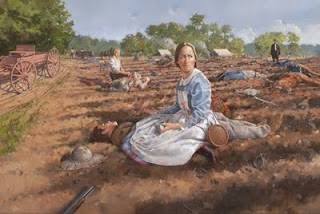Largest Military Hospital in the World
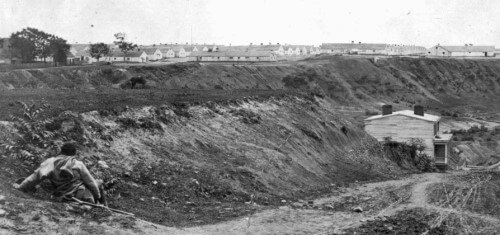
Image: Chimborazo Hospital in Richmond, Virginia
A man with a crutch looks out upon the long white buildings of Chimborazo Hospital on the hill above in a photograph taken just after the city had fallen to Union forces in April 1865.
Chimborazo Hospital in Richmond, Virginia essentially functioned as a village, complete with bathhouse, soap factory, morgues, and a bakery. Phoebe Yates Pember was one of the first women to serve as a hospital matron during the Civil War. Her memoirs describe in vivid detail her experiences as one of the first women to enter the previously all-male field of medicine in the Confederacy.
A Hospital on a Hill
Several million men went off to war in the early 1860s. They fell sick with disease and died from battle wounds by the hundreds of thousands. The Confederate government was not prepared for the sudden burden of caring for so many men. Hundreds of hospitals sprang up in the Confederate States, particularly in Richmond, where five railroads converged and close to many of the war’s battles.
On May 29, 1861, Confederate President Jefferson Davis arrived in Richmond. In June 1861, street cleaners and unemployed free blacks were put to work building the three lines of defense around Richmond. The interior line consisted of a series of forts; in the middle line, earthworks were constructed in a five-mile radius from the capitol building, with intermittent installations of artillery batteries; the outer line was a set of simple trenches that soldiers could quickly occupy if the city were threatened.
Essentially, there were three types of fortification surrounding the city – artillery batteries strategically placed to maximize the effectiveness against approaching troops, forts to house more artillery along with soldiers and supplies, and. They were made almost entirely of earth and wood, which is why you often see old photos of fortifications almost completely barren of any nearby trees.
During the summer of 1861, newly-enlisted Confederate troops inundated Richmond. The undeveloped forty-acre plateau in the city’s east end, known as Chimborazo Hill, was selected as a camp for soldiers. In late September and early October 1861, a workforce of slaves began erecting permanent winter quarters on the site. Plans called for soldiers’ barracks, officers’ quarters, three hospitals, and a large bake house.
The newly appointed Surgeon General of the Confederacy, Samuel Moore, soon recognized that Richmond’s ability to care for the army’s sick and wounded was sorely lacking. Many soldiers had died that previous summer because of the crowded conditions in the hotels, warehouses, stores, and private homes that had been used as makeshift hospitals. With many structures already in place on Chimborazo Hill, Moore decided to use the barracks as the beginnings of a hospital. He placed prominent Richmond physician, Dr. James B. McCaw, in command with the rank of surgeon-in-chief.
The nearly complete winter quarters – which measured about eighty feet by twenty-eight feet – were converted into patient wards. The walls were composed of two-inch-thick boards nailed to a simple vertical frame, and then a coat of whitewash inside and out. The workers covered the roofs with shingles and the floors with wood planks. Three doors and ten windows ran along each side for access and ventilation. There was a woodstove to fend off the cold, and a candle to show the way for the night shift of physicians.
Construction began in the autumn of 1861, and the complex grew to include ninety hospital wards, which were divided into five hospitals that could accomodate 3,600 patients at one time. In addition to the patient wards, Dr. McCaw’s crew built kitchens, five ice houses, a large stable, a guard house, a chapel, five mortuaries, and various shops, bringing the total number of buildings to nearly 150. Wide avenues separated the rows of buildings to provide fresh air, which Dr. McCaw believed necessary for a speedy recovery.
With the buildings arranged in this fashion, Chimborazo became the first pavilion-style hospital in America. An assistant surgeon described the scene:
The hospitals presented the appearance of a large town, imposing and attractive, with its alignment of buildings kept whitened with lime, streets and alleys clean … The buildings were separated from each other by wide alleys or streets, ample spaces for drives or walks, and a wide street around the entire camp or hospital.
Slaves at Chimborazo
In addition to the workforce of slaves who constructed the hospital buildings, Chimborazo relied on the slaves of local plantation owners to fill positions such as cooks and laundresses. Hundreds of African Americans, mostly enslaved males, served as nurses at Chimborazo Hospital. Slaves working at Chimborazo moved from a private to a public work environment and worked alongside free blacks, which must have been somewhat liberating.
Dr. James McCaw recognized early on the necessity of employing blacks for the hospital’s own survival:
I have at this time only two hundred and fifty-six cooks and nurses [slaves] in my Hospitals, to take care of nearly 4,000 sick soldiers … it will be entirely impossible to continue the hospital without them.
Patient Care
Dr. McCaw first had to organize the massive facility. Contract surgeons were hired as needed, and civilian doctors occasionally volunteered their services. McCaw purchased hospital rations from local suppliers, and for the good of his patients, he established a large vegetable garden and a herd of hundreds of goats and milk cows a nearby farm.
In the summer of 1862, the constant dread that must have niggled at the mind of every person employed there came to pass. Wounded from the Seven Days’ Battles filled the hospital beyond capacity. To accommodate the overflow, hospital workers set up Sibley tents, which housed eight to ten soldiers per tent, and the hospital continued to function as before.
The level of medical care within Chimborazo Hosptial varied greatly. Many accounts praised the doctors and the care provided by the female matrons. However, some patients complained that sufficient food was sometimes unavailable and some wards were poorly supervised. Some eyewitnesses went so far as to pronounce the medical staff negligent and the environment filthy and foul-smelling. However, the system worked. Throughout its existence, Chimborazo had a mortality rate of about nine percent; the best-staffed Union hospitals achieved only ten percent.
The Matron Law
On September 27, 1862, Confederate President Davis signed into law “an act to better provide for the sick and wounded of the Army in hospitals.” The law provided that each hospital could employ two chief matrons at salaries not to exceed forty dollars per month to “exercise a superintendence over the entire domestic economy of the hospital.” Each facility could hire two assistant matrons “to superintend the laundry, to take charge of the clothing of the sick, [and] the bedding of the hospital, to see that they are kept clean and neat.” These women received compensation up to thirty-five dollars per month. Each ward could employ two ward matrons for salaries of thirty dollars per month whose duties were:
to prepare the beds and bedding of their respective wards, to see that they are kept clean and in order, that the food or diet for the sick was carefully prepared and furnished to them, the medicine administered, and that all patients requiring careful nursing are attended to.
For the rest of the war, white Southern women managed Confederate hospitals as matrons. Those who filled these positions had to be blessed with the stamina to endure physical and mental hardships and the will to defy conventional ideas about their proper role in southern society. In addition to their salaries, all matrons received rations and suitable lodging. Matrons were not nurses. Most Civil War nurses in Confederate hospitals were hired slaves, free blacks, or convalescent soldiers. Matrons were almost always white women.
Phoebe Yates Pember
In her book Mothers of Invention: Women of the Slaveholding South in the American Civil War, Drew Gilpin Faust states that only a few “exceptional women” dedicated their lives to work as hospital matrons. Phoebe Yates Pember was one of the first women to serve as a hospital matron, and she served in that position at the largest military hospital in the world: Chimborazo. Pember’s memoirs describe the difficulties she encountered as one of the first women to enter the all-male field of medicine.
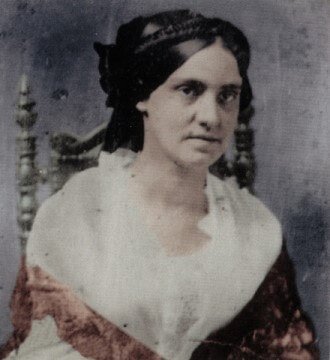 Image: Phoebe Yates Pember
Image: Phoebe Yates Pember
Matron at Chimborazo Hospital
Pember was born into a prosperous and socially prominent Jewish family in Charleston, South Carolina who later moved to Georgia. When her husband of five years died of tuberculosis in Boston on July 9, 1861, Pember joined her family, who had left the coastal city of Savannah for the supposedly safer town of Marietta, Georgia; they would spend the rest of the war as refugees.
In late 1862, Pember received a letter from her friend Mary Elizabeth Adams Pope Randolph, wife of the Confederate secretary of war. Randolph was active in the Richmond Ladies Association, which organized relief efforts for Confederate soldiers. Randolph offered Pember a position as chief matron of Chimborazo Hospital’s Second Division, one of five hospital divisions. It was “rather a startling proposition to a woman used to all the comforts of luxurious life,” Pember later wrote in her memoirs, but she reported for duty at the age of 39.
While working at the hospital, Pember not only dealt with the pain and suffering of her patients, but also with shortages of medicine, food and equipment. In addition, she dealt with doctors as well as a society that criticized women for working in hospitals, to which she responded:
In the midst of suffering and death, hoping with those almost beyond hope in this world; praying by the bedside of the lonely and heart stricken; closing the eyes of the boys hardly old enough to realize man’s sorrows, much less suffer man’s fierce hate, a woman must soar beyond the conventional modesty considered correct under different circumstances.
Pember made sure that the orders of surgeons were performed properly, and that the medical and dietary needs of her patients were fulfilled. As the war progressed, casualties multiplied and Phoebe’s duties increased. She continually washed and dressed minor wounds and prepared the most difficult cases for the surgeons. She eventually found some respite from her duties by renting a room in town, to which she returned every night.
By the end of the Civil War, 76,000 patients had received medical care at Chimborazo; 15,000 of those were under Phoebe Pember’s supervision in the 150 wards she managed. She remained at Chimborazo until the facility was taken over by Federal authorities and her last patients were discharged. At the end of the war, she wrote, “I found myself with a box full of Confederate money and a silver ten-cent piece.” She spent the 10 cents on a box of matches and five coconut cakes.
Phoebe Pember then returned to Savannah, where she maintained her elite social status, and traveled in the United States and Europe. In 1879, her memoirs A Southern Woman’s Story: Life in Confederate Richmond was published. It is considered a pioneering resource in women’s history. During her last years she lived with her niece, Fanny Phillips Hill in Pittsburgh, Pennsylvania, where she died on March 4, 1913 of breast cancer.
Fall of Richmond
Because Richmond never endured a direct attack, Chimborazo operated safely throughout the Civil War. However, on April 2, 1865, Union forces penetrated Confederate defensive lines around Petersburg, twenty-three miles south of Richmond. When General Robert E. Lee‘s Army of Northern Virginia retreated to the west, Richmond was no longer protected and had to be evacuated. Those of Chimborazo’s patients who were able began leaving on their own, while the staff and those too sick or injured to travel waited for the arrival of Union troops. Dr. McCaw surrendered the hospital to a group of Union surgeons on April 3, 1865. Soon after, ambulances began delivering Union patients, who were placed in separate wards away from the Confederates.
Freedmen’s Bureau School at Chimborazo
By the early summer of 1865, patients had been removed from a section of the hospital, which was then designated as classrooms for a Freedmen’s Bureau school. Two months after the fall of Richmond, the village on Chimborazo Hill was providing a home as well as an education for thousands of former slaves. Quaker societies like the New York Friends’ Association supported the school, and they sent white Quaker women from the northeast to serve as teachers. Almost 200 newly-freed slaves enrolled in an afternoon session, and by fall their number had increased to 345.
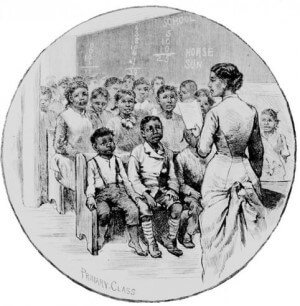 Image: Freedmen’s Bureau Classroom
Image: Freedmen’s Bureau Classroom
At Chimborazo School for slaves
The Freedmen’s Bureau was a federal agency established to assist freed slaves in finding education and employment. They also used the former barracks and other buildings to house the flood of African American refugees pouring into Richmond. One ward was inhabited by 1,500 ex-slaves, some of whom were employed by Union authorities to begin cleaning up the city.
Sometime after 1869, the Freedmen’s Bureau school at Chimborazo closed its doors, probably due to the ratification of the new Virginia Constitution, which required a public school system for all Virginia children. According to the Richmond Public Schools, in 1869, rooms were rented nearby to educate African American children. In 1881, a new school building was constructed, which eventually became today’s George Mason Elementary School.
The buildings at Chimborazo disappeared quickly after that. Local residents, desperate for firewood, tore down the hospital wards and burned them in their fireplaces and stoves.
In 1874, when the city purchased Chimborazo Hill to be used as a park, few buildings remained. In 1909, a United States Weather Bureau Station was constructed on the site. In 1959 the National Park Service acquired six acres of Chimborazo Hill, including the weather station building, which now serves as a visitor center for Richmond National Battlefield Park and the Chimborazo Medical Museum. The museum offers a great deal of information about the famous hospital, other hospitals in Civil War Richmond, and the practice of medicine in the 1860s.
SOURCES
NPS.gov: Chimborazo Hospital
Encyclopedia Virginia: Chimborazo Hospital
The Freedmen’s Bureau School of Chimborazo
Confederate Matrons: Women Who Served in Virginia Civil War Hospitals – PDF
